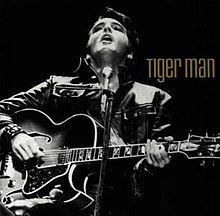Tiger Man (album)
| Tiger Man | ||||
|---|---|---|---|---|
 |
||||
| Compilation album by Elvis Presley | ||||
| Released | September 15, 1998 | |||
| Recorded | June 27, 1968 | |||
| Genre | Rock and roll | |||
| Label | RCA | |||
| Elvis Presley chronology | ||||
|
||||
| Professional ratings | |
|---|---|
| Review scores | |
| Source | Rating |
| Allmusic | |
Tiger Man is a compilation from American singer and musician Elvis Presley consisting of tracks from his second comeback concert in 1968.
Personnel includes: Elvis Presley (vocals, acoustic and electric guitar); Scotty Moore (electric and acoustic guitar), D.J. Fontana (percussion with drumsticks on guitar case). Presley's friend Alan Fortas also provides percussion on a guitar case, with hands. Lance LeGault is on tambourine, just off the stage, near Presley. Compilation producers: Ernst Mikael Jorgensen, Roger Semon.Engineers: Al Pachucki, Mike Moran, Dick Baxter. Recorded at NBC Studio 4, Burbank, California on June 27, 1968. Includes liner notes by Colin Escott. Out of two small "concerts" Elvis Presley recorded for his "comeback" TV special on June 27, 1968, TIGER MAN is the entire second show and featured 7 previously unreleased songs.
Audio Mixer: Dennis Ferrante. Liner Note Author: Colin Escott. Recording information: 06/27/1968.
During the most captivating segment of Elvis Presley's phenomenal 1968 television comeback special, Presley reunited with original band members Scotty Moore and D.J. Fontana. (Bass player Bill Black died in the mid-1960s.) To film that segment, Presley and the group performed two sets before a small, but rapt studio audience. A generous selection of performances from those concerts became available on video in 1985 under the title "Elvis: One Night With You," but RCA waited until 1998 to release TIGER MAN, a single CD of the performances. Surely, most rock and blues music aficionados who have ever seen "One Night With You" will not need much convincing to buy TIGER MAN. These performances quite simply capture Presley at his best, singing with a joy and fire absent from much of his 1960s output. At the same time, Presley is clearly giving it his all, as if trying to undo in one brief set all the damage that years of safe, mediocre movies did to his image. An unusual and stunning aspect is that Presley "swaps axes" - the electric guitar - with Moore early in the set. Instead of Moore's groundbreaking country-blues fusion guitar licks, we hear something completely new and unexpected. Presley's wild, thrashing, and incendiary rhythmic lead guitar playing reveals a side of Elvis Presley's musicianship previously unheard on disc. It is not something serious music fans want to miss, and it is displayed very well on this album.
He had played the electric guitar live before, on a very few occasions. And he played it on record both before and after the special.
But there is no other recorded evidence of THIS kind of playing. Moore is generous, giving his friend and bandmate room to shine, while he either gently fingerpicks or strums along with Presley, and Presley's strumming friend Charlie Hodge.
...
Wikipedia
